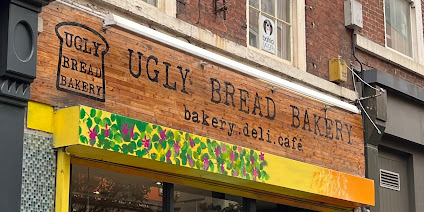One of our hosts, in Tunbridge Wells, has a delightful garden. The city is located in Kent, which is a county south of London. England as a country has no states, but rather lots of counties, like Hampshire, Yorkshire, and Devon, which seems to have lost its shire. Homes have addresses in England, but they are also sometimes given names. Our host lives in the Sandstone House. Are all english gardens like this? I'd be fine with it if so. Sheep graze peacefully in the front yard. Had never seen baby sheep grazing before. They're doing a great job.
Pink flamingoes are an indicator species for quirky habitat. Real flamingoes can be found in Africa and America. I once saw flocks of them at watering holes at the base of the Andes in the Patagonian desert in Argentina. Plastic pink flamingoes (Phoenicopterus plasticus) are a northern species, reportedly native to Massachusetts.
There was a very scary guard dog, fortunately leashed.
And a guard bird kept an eye on us. People underestimate guard birds at their peril.
The garden deals with the death of trees in an interesting way. People tend to eliminate all signs of death from their gardens, but our hosts see demise as an opportunity. What's this?, you might ask.
I did ask, and was told that it's a thumb. That's a very positive thing to do with a dead tree trunk.
And that split trunk in the distance, instead of cutting it down,
they added a rope and called it a sling-shot.
If you've been steeped in the American ethic that trees should be allowed to grow naturally, the European treatment of trees can seem at first brutal. This eucalyptus, native to Australia, is lucky to have any limbs. Radical pruning is a means of controlling size, and is reminiscent of how grape vines are pruned back each year to not much more than a post sticking out of the ground. New growth sprouts from the tips. Pollarding is a fascinating technique with a long history, and some examples, intentional or not, can be found in Princeton.
Most jazz musicians, leaving the gig, would not have noticed the teasel growing in the little butterfly garden that was trying mightily to do its part to counter 50 years of decline in butterflies and moths in Great Britain. Apparently native to England, teasel is a plant with a striking form that unfortunately has become highly invasive in the midwestern U.S., forming thick stands along highways. It probably will become problematic in NJ over time. Typically there's a lack of indigenous herbivores and diseases to keep an introduced plant in check when it becomes invasive on other continents. Teasel is, as mentioned, a striking plant, sometimes used in dry flower arrangements. Invasive is another way of saying "too much of a good thing." It would be interesting to see how teasel behaves in the English landscape, beyond the confines of a 10 X 20 butterfly garden.
There's a wonderful post about Virginia creeper by a woman in London who describes herself this way: "Bug Woman is a slightly scruffy middle-aged woman who enjoys nothing more than finding a large spider in the bathroom."
which was just up the street from the Fatface department store. Do words get upcycled in England, to turn a negative into a positive? Though people were not above occasional complaint, we picked up on considerable positive energy, with the word "brilliant" being sprinkled liberally upon various things and actions, the way we might use "awesome."


































































